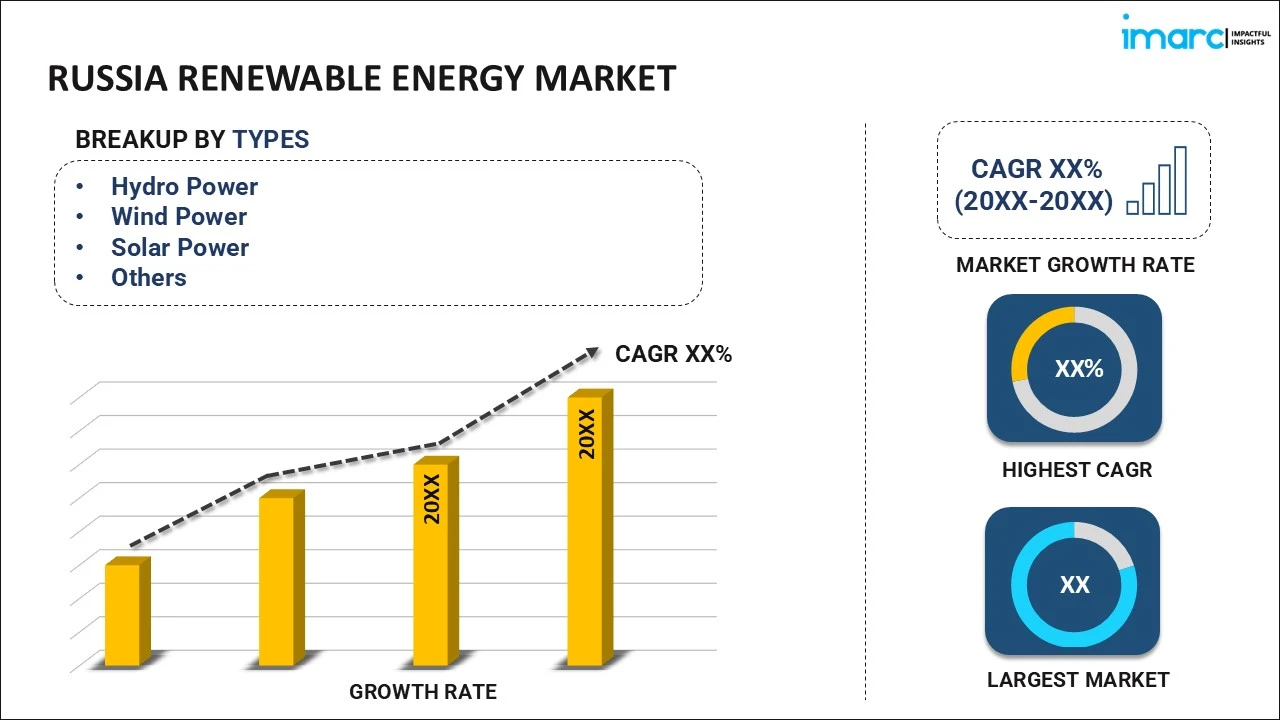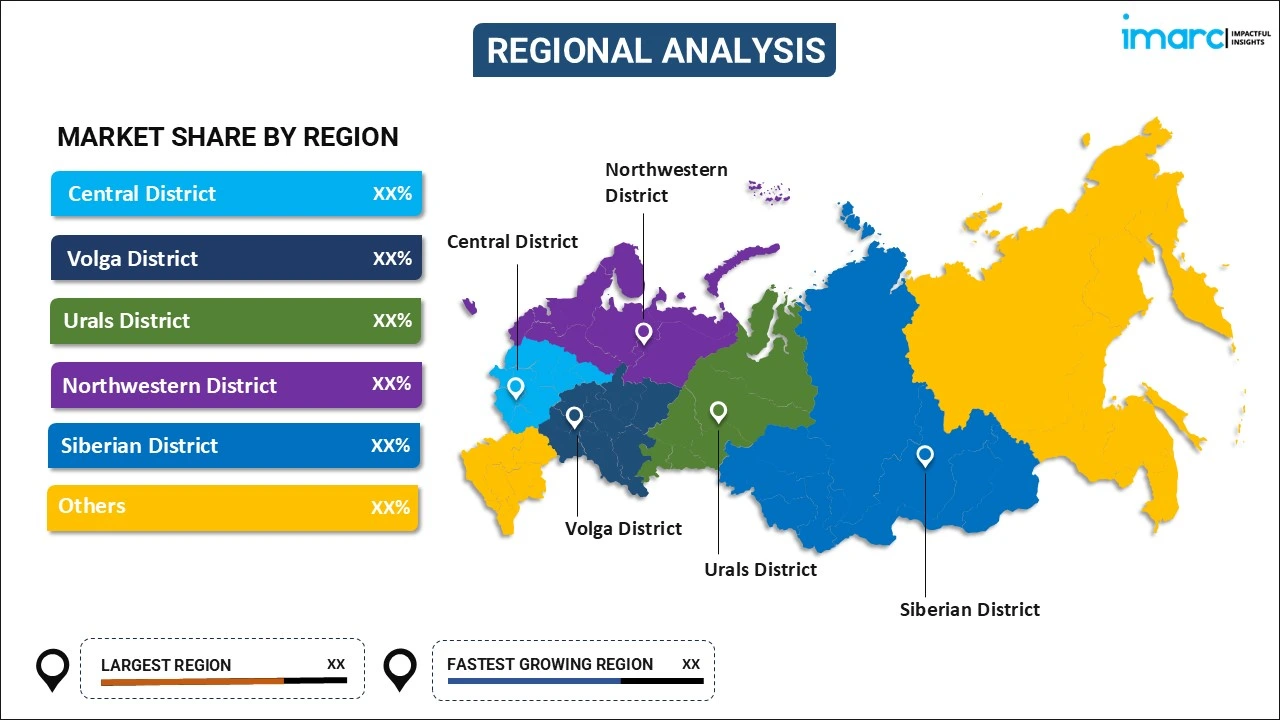
Russia Renewable Energy Market Report by Type (Hydro Power, Wind Power, Solar Power, Bioenergy, and Others), End User (Industrial, Residential, Commercial), and Region 2025-2033
Russia Renewable Energy Market Overview:
The Russia renewable energy market size is projected to exhibit a growth rate (CAGR) of 9.3% during 2025-2033. The growing development of more efficient and cost-effective wind turbines and solar panels, presence of extensive land area and river systems in the country and increasing development of smart grid technologies to improve the efficiency and reliability of energy distribution are some of the factors impelling the market growth.
|
Report Attribute
|
Key Statistics
|
|---|---|
|
Base Year
|
2024 |
|
Forecast Years
|
2025-2033 |
|
Historical Years
|
2019-2024
|
| Market Growth Rate (2025-2033) | 9.3% |
Russia Renewable Energy Market Trends:
Abundant Renewable Resources
The extensive land area of Russia offers numerous high-potential locations for solar and wind energy. Additionally, the extensive river system provides notable opportunities for hydropower development. The availability of agricultural and forestry residues presents the potential for biomass energy. By harnessing these resources, Russia is expanding its energy mix and lessening its dependence on fossil fuels. These geographic and climatic advantages create a strong foundation for the development of the renewable energy sector, making it an attractive investment opportunity for both domestic and international stakeholders. This potential for renewable energy development aligns with efforts to move towards cleaner energy sources. This shift towards cleaner energy sources enhances the Russia renewable energy market share, attracting both domestic and international investment.
Modernization of Energy Infrastructure
Investments from both the government and private sectors are focusing on upgrading and expanding the national grid to integrate renewable energy sources better. This modernization involves the advancement of smart grid technologies, enhancing the efficacy and dependability of energy distribution. Enhanced transmission infrastructure is crucial for ensuring a stable supply and minimizing energy losses. Furthermore, these funds aid in the implementation of decentralized energy systems including microgrids and distributed generation, which are vital for maximizing the effective use of renewable energy. By updating its infrastructure, the country is able to decrease reliance on fossil fuels, reach a more environment-friendly energy future, and maximize its abundant renewable resources. For instance, according to the Worldwide Look at Reserves and Production, published by the Oil & Gas Journal, as of January 1, 2024, Russia confirmed oil reserves of 80 billion barrels and the largest natural gas reserves, amounting to 1,688 trillion cubic feet (Tcf).
Technological Advancements and Innovation
The development of more efficient and cost-effective renewable energy technologies like advanced wind turbines and solar panels is making it feasible to harness renewable energy resources even in the challenging climatic conditions of the country. Moreover, advancements in energy storage and grid integration are improving the dependability and resilience of renewable energy systems. Furthermore, rising research and development (R&D) efforts, backed by partnerships between the government and private sector, are resulting in advancements in renewable energy technologies. These developments are reducing the price of producing renewable energy, increasing its competitiveness with fossil fuels. In 2024, Eco News announced that Russia created an innovative solar panel technology with 80% efficiency, signaling the obsolescence of traditional silicon-based panels. The new perovskite-silicon solar thermal modules, produced in collaboration with Sunmaxx PVT and Oxford PV, combined electrical and thermal efficiencies to achieve this record performance.
Russia Renewable Energy Market News:
- December 2024: Rosatom Renewable Energy began construction on a 300 MW wind power plant in Daghestan, Russia. The project, which will be completed in two phases by 2026, will become Russia's largest wind park, generating 879 GWh/year. Wind energy currently makes up less than 1% of Russia’s installed capacity, with over 4 GW in development.
- December 2024: Rosatom launched a wind turbine blade factory in Ulyanovsk, Russia. The factory will produce up to 450 blades annually, supporting Rosatom's 300-MW Novolakskaya wind project in Dagestan. This move enhances Russia's wind energy capabilities and aims to increase equipment localization from 68% to 85%.
- November 2024: The Centre for Energy and Environment at MNIT Jaipur organized a Joint Indo-Russia Workshop on enhancing clean energy generation through anaerobic bioconversion of organic waste using solar energy. The event was part of a joint research project on bio-energy, featuring Russian Academy of Sciences delegates.
- August 2024: China and Russia agreed to deepen their cooperation in renewable energy, hydrogen energy, energy storage, and carbon markets. They aim to leverage each other's strengths, with Russia's vast potential in solar and wind energy and China's leading position in new-energy industrial chains. This partnership is expected to boost their energy transition and create new growth opportunities in green energy.
- February 2023: The Russia Renewable Energy Development Association (RREDA) reported that Russia had installed 438 MW of renewable energy capacity in 2023. The nation plans to increase its renewable capacity to 2.17 GW by 2025, including the addition of 482 MW in 2024.
- December 2023: Russia stated its intention to increase its renewable power capacity from 6 GW to 12 GW by 2030 during the UN COP28 climate conference. The First Deputy Economic Development Minister emphasized that there were 110 projects underway, totaling 4 GW in capacity, with a further 2 GW planned.
Russia Renewable Energy Market Segmentation:
IMARC Group provides an analysis of the key trends in each segment of the market, along with forecasts at the country level for 2025-2033. Our report has categorized the market based on type and end user.
Type Insights:

- Hydro Power
- Wind Power
- Solar Power
- Bioenergy
- Others
The report has provided a detailed breakup and analysis of the market based on the type. This includes hydro power, wind power, solar power, bioenergy, and others.
End User Insights:
- Industrial
- Residential
- Commercial
A detailed breakup and analysis of the market based on the end user have also been provided in the report. This includes industrial, residential, and commercial.
Regional Insights:

- Central District
- Volga District
- Urals District
- Northwestern District
- Siberian District
- Others
The report has also provided a comprehensive analysis of all the major regional markets, which include Central District, Volga District, Urals District, Northwestern District, Siberian District, and Others
Competitive Landscape:
The market research report has also provided a comprehensive analysis of the competitive landscape in the market. Competitive analysis such as market structure, key player positioning, top winning strategies, competitive dashboard, and company evaluation quadrant has been covered in the report. Also, detailed profiles of all major companies have been provided.
Russia Renewable Energy Market Report Coverage:
| Report Features | Details |
|---|---|
| Base Year of the Analysis | 2024 |
| Historical Period | 2019-2024 |
| Forecast Period | 2025-2033 |
| Units | Billion USD |
| Scope of the Report | Exploration of Historical Trends and Market Outlook, Industry Catalysts and Challenges, Segment-Wise Historical and Future Market Assessment:
|
| Types Covered | Hydro Power, Wind Power, Solar Power, Bioenergy, Others |
| End Users Covered | Industrial, Residential, Commercial |
| Regions Covered | Central District, Volga District, Urals District, Northwestern District, Siberian District, and Others |
| Customization Scope | 10% Free Customization |
| Post-Sale Analyst Support | 10-12 Weeks |
| Delivery Format | PDF and Excel through Email (We can also provide the editable version of the report in PPT/Word format on special request) |
Key Benefits for Stakeholders:
- IMARC’s industry report offers a comprehensive quantitative analysis of various market segments, historical and current market trends, market forecasts, and dynamics of the Russia renewable energy market from 2019-2033.
- The research report provides the latest information on the market drivers, challenges, and opportunities in the Russia renewable energy market.
- Porter's five forces analysis assist stakeholders in assessing the impact of new entrants, competitive rivalry, supplier power, buyer power, and the threat of substitution. It helps stakeholders to analyze the level of competition within the Russia renewable energy industry and its attractiveness.
- Competitive landscape allows stakeholders to understand their competitive environment and provides an insight into the current positions of key players in the market.
Key Questions Answered in This Report
IMARC estimates the Russia renewable energy market to exhibit a CAGR of 9.3% during 2025-2033.
Key factors driving the Russia renewable energy market include growing government support for green energy initiatives, a focus on reducing carbon emissions, and advancements in renewable technologies. Additionally, the need for energy diversification, rising global demand for clean energy, and Russia's vast renewable resources, such as wind, solar, and hydropower, further contribute to market growth.
Need more help?
- Speak to our experienced analysts for insights on the current market scenarios.
- Include additional segments and countries to customize the report as per your requirement.
- Gain an unparalleled competitive advantage in your domain by understanding how to utilize the report and positively impacting your operations and revenue.
- For further assistance, please connect with our analysts.
 Inquire Before Buying
Inquire Before Buying
 Speak to an Analyst
Speak to an Analyst
 Request Brochure
Request Brochure
 Request Customization
Request Customization




.webp)




.webp)












